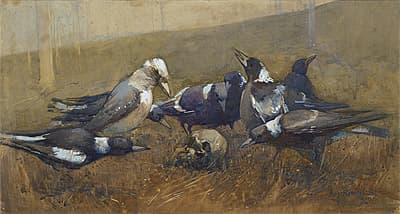
Sydney
LONG
Australia
1871
–
London
1955
England, Europe 1910-21; Australia 1921- 22; England 1922-25; Australia 1925-52; England from 1952
29.0 (h) x 54.5 (w) cm
signed and dated ‘SYDNEY LONG/ 1909’ lower right private collection
In An incident in the bush, Long created a narrative depicting a group of magpies with a kookaburra standing around a skull. He animated the birds in such a way that they appear to be discussing what they see before them. Behind the birds is an Art Nouveau stand of white tree trunks, and a smoky haze, suggesting that a bushfire may have recently passed through this area.
Long included magpies in a number of his works, in particular The music lesson
(cat 19) and The West Wind (cat 33). Long exhibited a watercolour of magpies in the Royal Academy 1918, and he produced three etchings of the subject including
A windy day (cat 93). The etching Magpies (The early bird) 1920 is in many ways a variation of this watercolour.
The magpie is a common bird, seen in parks and suburban gardens across many parts of Australia, although it is not unique to this country. It is easily recognised, with its black head, belly and tail tip, and splashes of white on its wings. In European folklore, the magpie is sometimes considered to be an omen of ill fortune, a reputation that could be based on its inclination to ‘steal’ anything it can carry away – particularly shiny objects – and its aggressive behaviour towards other birds. The magpie also has a reputation for gossiping, which the magpies in Long’s image appear to be doing.
In An incident in the bush, Long created a narrative depicting a group of magpies with a kookaburra standing around a skull. He animated the birds in such a way that they appear to be discussing what they see before them. Behind the birds is an Art Nouveau stand of white tree trunks, and a smoky haze, suggesting that a bushfire may have recently passed through this area.
Long included magpies in a number of his works, in particular The music lesson
(cat 19) and The West Wind (cat 33). Long exhibited a watercolour of magpies in the Royal Academy 1918, and he produced three etchings of the subject including
A windy day (cat 93). The etching Magpies (The early bird) 1920 is in many ways a variation of this watercolour.
The magpie is a common bird, seen in parks and suburban gardens across many parts of Australia, although it is not unique to this country. It is easily recognised, with its black head, belly and tail tip, and splashes of white on its wings. In European folklore, the magpie is sometimes considered to be an omen of ill fortune, a reputation that could be based on its inclination to ‘steal’ anything it can carry away – particularly shiny objects – and its aggressive behaviour towards other birds. The magpie also has a reputation for gossiping, which the magpies in Long’s image appear to be doing.
In An incident in the bush, Long created a narrative depicting a group of magpies with a kookaburra standing around a skull. He animated the birds in such a way that they appear to be discussing what they see before them. Behind the birds is an Art Nouveau stand of white tree trunks, and a smoky haze, suggesting that a bushfire may have recently passed through this area.
Long included magpies in a number of his works, in particular The music lesson
(cat 19) and The West Wind (cat 33). Long exhibited a watercolour of magpies in the Royal Academy 1918, and he produced three etchings of the subject including
A windy day (cat 93). The etching Magpies (The early bird) 1920 is in many ways a variation of this watercolour.
The magpie is a common bird, seen in parks and suburban gardens across many parts of Australia, although it is not unique to this country. It is easily recognised, with its black head, belly and tail tip, and splashes of white on its wings. In European folklore, the magpie is sometimes considered to be an omen of ill fortune, a reputation that could be based on its inclination to ‘steal’ anything it can carry away – particularly shiny objects – and its aggressive behaviour towards other birds. The magpie also has a reputation for gossiping, which the magpies in Long’s image appear to be doing.
